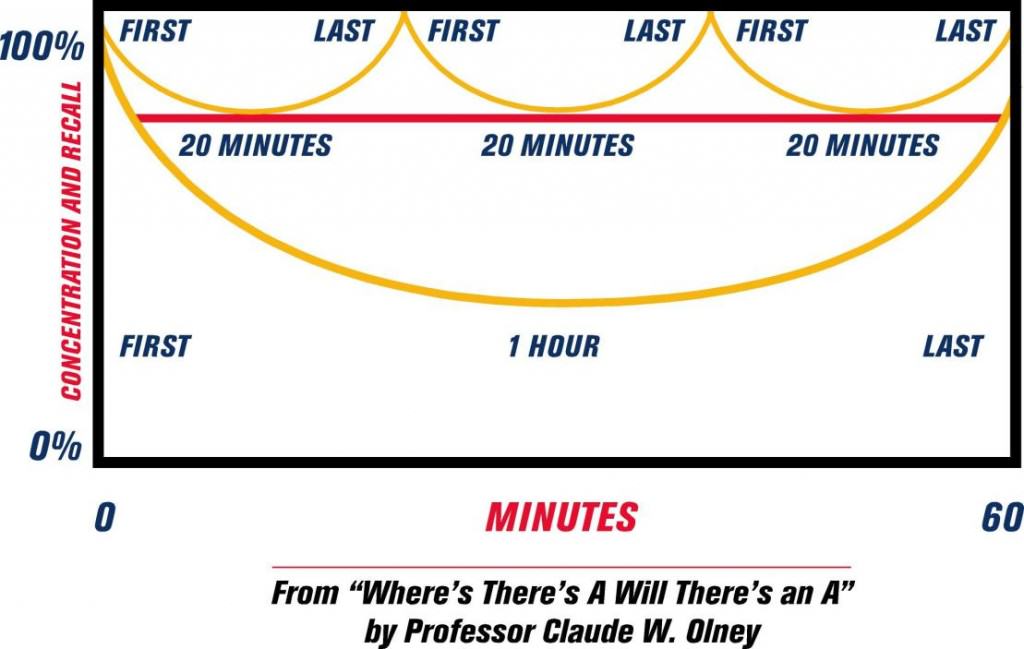Are You Spending TOO MUCH Time Learning? (Or,Teaching?)
“Small-chunk” learning is the most undervalued concept in education! We have all been raised with this notion that effective learning and good grades can only come from a massive investment of time of energy.
That notion is not only wrong, it’s harmful! It turns a lot of eager, willing, and smart people off to learning.
Just watch a two-year old explore his world and you will see evidence that we are born with a natural, innate desire to learn. Learning should be fun! But, the inherent excitement that learning should inspire is washed away when it’s drawn out in endless lectures and study sessions.
Long lectures and study sessions are not only boring, they are very ineffective! The chart below illustrates the different levels of retention between a long, 60-minute study session and three, 20-minute study sessions.
Since our brain has a tendency to remember the “first and last” things we learn at a given time, increasing the number of “firsts and lasts” increases our retention. As you see in this chart, all of the “learning” that takes place below the red line in the 60-minute session has a tendency to get lost or “disorganized” in our brain and difficult to access for recall.
The shorter sessions yield more effective results.
We still have a lot of “cave-man” in our DNA, so we are naturally programmed according to the “fight or flight” response. This means that our bodies and brains are designed to sustain short periods of high-level energy and concentration, not long, drawn-out learning sessions.
The more we can accommodate shorter sessions in our learning (and teaching) the more we are working according the physiological make-up of our brains.
As both a student and a teacher, I was very guilty of drawing things out. As a teacher, I had a tendency to drill and kill on concepts.
I would think, “Oh, it looks like they aren’t getting ‘it.’ I guess I have to extend this lesson a bit more…” Before I would know it, 40-45 minutes had passed, but I don’t think I ever felt much better about the students’ progress.
I remember a lecture by a PhD author of a well-know reading series. One of his greatest concerns about the implementation of his program was, as he said, “Teachers are not keeping these mini-lessons ‘mini!’” I instantly knew what he was talking about; I was guilty as charged!
As a student, I would hold marathon study sessions for hours at a time. They were pure misery for me, but that was how I thought I should be studying. After all, I wouldn’t really deserve an “A” unless I had hours of blood, sweat, and tears to show for it.
Most recently, I have been reaping the rewards of “short study sessions” with my first-grade son. With his attention span, we get five minutes (ten, at best) of good learning time before he’s flitting out of his seat, falling over on the table, and totally out of sync. We make our best progress (and he has his best level of retention) when we keep his work sessions to under ten minutes.
This means that his daily homework tasks are spread out over a few times a day. In the morning, we work on handwriting for ten minutes before school.
If he has more than ten minutes of homework after school, it has to be broken up into different sessions or we end up fighting. (This is really hard for me to do…I would rather just “get it done” in one shot.)
We practice his independent readers for the first five-ten minutes of bedtime. His weekly spelling words are reviewed daily in the car, traveling to and from school.
On weekends, when we have longer road trips to visit grandparents, we work on reading or spelling words. When he tells me he’s had enough, I oblige.
This concept has applications for older students, too. Just a couple of days ago, my husband Brian (a high school teacher), came home very frustrated. His seniors have been struggling with an important topic that they must master in order to pass their “exit presentations,” a requirement for graduation.
In these presentations, students have to highlight 14 different, career-related skills they have learned in high school and explain how those skills will help them in the work world. However, many students have been failing their presentations because their career connections are weak.
The major source of Brian’s anxiety was a lack of time; for a variety of reasons, he just didn’t feel like he had the time to give this topic the level of attention he felt it deserved. So, I suggested he try some “rapid fire” review sessions.
“For the first five minutes and last five minutes of each class period for the next week, do ‘rapid fire’ reviews. Pick one of the 14 skills and call on students to describe a career connection in 30 seconds or less.
Then, you give a quick ‘thumbs-up’ or a brief explanation on how they should correct/expand their connection to make it acceptable for the presentation. Then, keep going. Keep it fast-paced and very focused…”
Brian’s situation is not unique; we all have times when we think we don’t have the time to teach or learn what needs to be covered. In those situations, maybe what we need to do is flip things around…and go shorter!
-Susan Kruger
EB 090817
Six Steps to
Conquer the Chaos
Get Our Free Guide & Information on...

"*" indicates required fields
SOAR® in the News
The SOAR® Curriculum
The most critical learning, organizing, and communication skills needed for school. Learn more here.
Who’s Using SOAR®?
SOAR® Guarantee
Click here to learn more.





